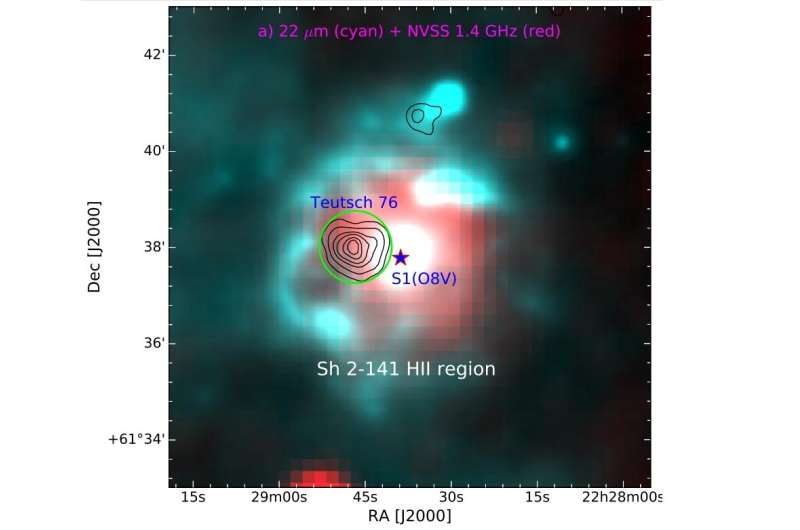Indian astronomers inspect open cluster Teutsch 76 in detail

Using the 3.6m Devasthal Optical Telescope (DOT), Indian astronomers have performed detailed deep near-infrared observations of a Galactic open cluster known as Teutsch 76. Results of the observational campaign, published February 9 on the arXiv pre-print server, shed more light on the properties of this cluster.
Open clusters (OCs), formed from the same giant molecular cloud, are groups of stars loosely gravitationally bound to each other. So far, more than 1,000 of them have been discovered in the Milky Way, and scientists are still looking for more, hoping to find a variety of these stellar groupings. Expanding the list of known galactic open clusters and studying them in detail could be crucial for improving our understanding of the formation and evolution of our galaxy.
Teutsch 76 (or T76 for short) is a poorly studied Galactic OC in the eastern part of an ionized atomic hydrogen region (HII region) designated Sh 2-141, which is estimated to be located some 24,500 light years away. Recently, a group of astronomers led by Saurabh Sharma of the Aryabhatta Research Institute of Observational Sciences (ARIES) in India, observed T76 with DOT in order to get more insights into the properties of this cluster. The study was complemented by data from ESA’s Gaia satellite and from the Pan-STARRS1 survey.
“We have performed a detailed analysis on this cluster to understand its dynamical evolution by using our deep near-infrared (NIR) observations taken from the TIFR-ARIES Near-infrared Spectrometer recently installed on the 3.6m telescope at Devasthal, Nainital, India, along with the recently available data from the Gaia Data Release 3 and PanSTARRS1,” the researchers wrote in the paper.
The study found that T76 has a radius of approximately 4.04 light years and its age is estimated to be 50 million years. The observations suggest that the cluster is located some 18,600 light years away from the Earth.
The results indicate that T76 showcases an central density concentration with circular morphology, most likely due to the star formation processes. The astronomers noted that the cluster is still under the process of dynamical evolution and does not show any signatures of mass-segregation. In general, the distribution of stars in T76 may be similar to the distribution found in the solar neighborhood.
The researchers identified 28 stars within the derived radius of T76, marking them as highly probable cluster members. The membership probability of these stars was calculated to be at least 80%.
The scientists added that there might be a probability of finding young stars in T76 with excess infrared emission, given that the cluster seems to be associated with an HII region. They tried to find them using the conventional near-infrared color based selection criteria; however, no such star has been detected.
More information:
Saurabh Sharma et al, Teutsch 76: a Deep Near-Infrared Study, arXiv (2023). DOI: 10.48550/arxiv.2302.04516
© 2023 Science X Network
Citation:
Indian astronomers inspect open cluster Teutsch 76 in detail (2023, February 16)
retrieved 16 February 2023
from https://phys.org/news/2023-02-indian-astronomers-cluster-teutsch.html
This document is subject to copyright. Apart from any fair dealing for the purpose of private study or research, no
part may be reproduced without the written permission. The content is provided for information purposes only.
For all the latest Science News Click Here
For the latest news and updates, follow us on Google News.

